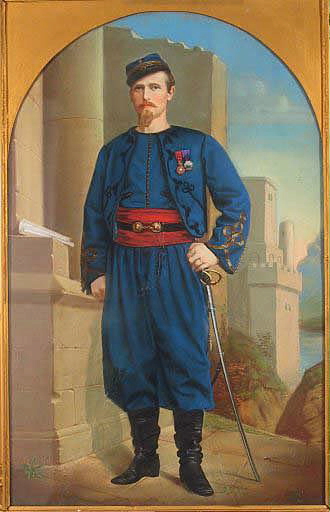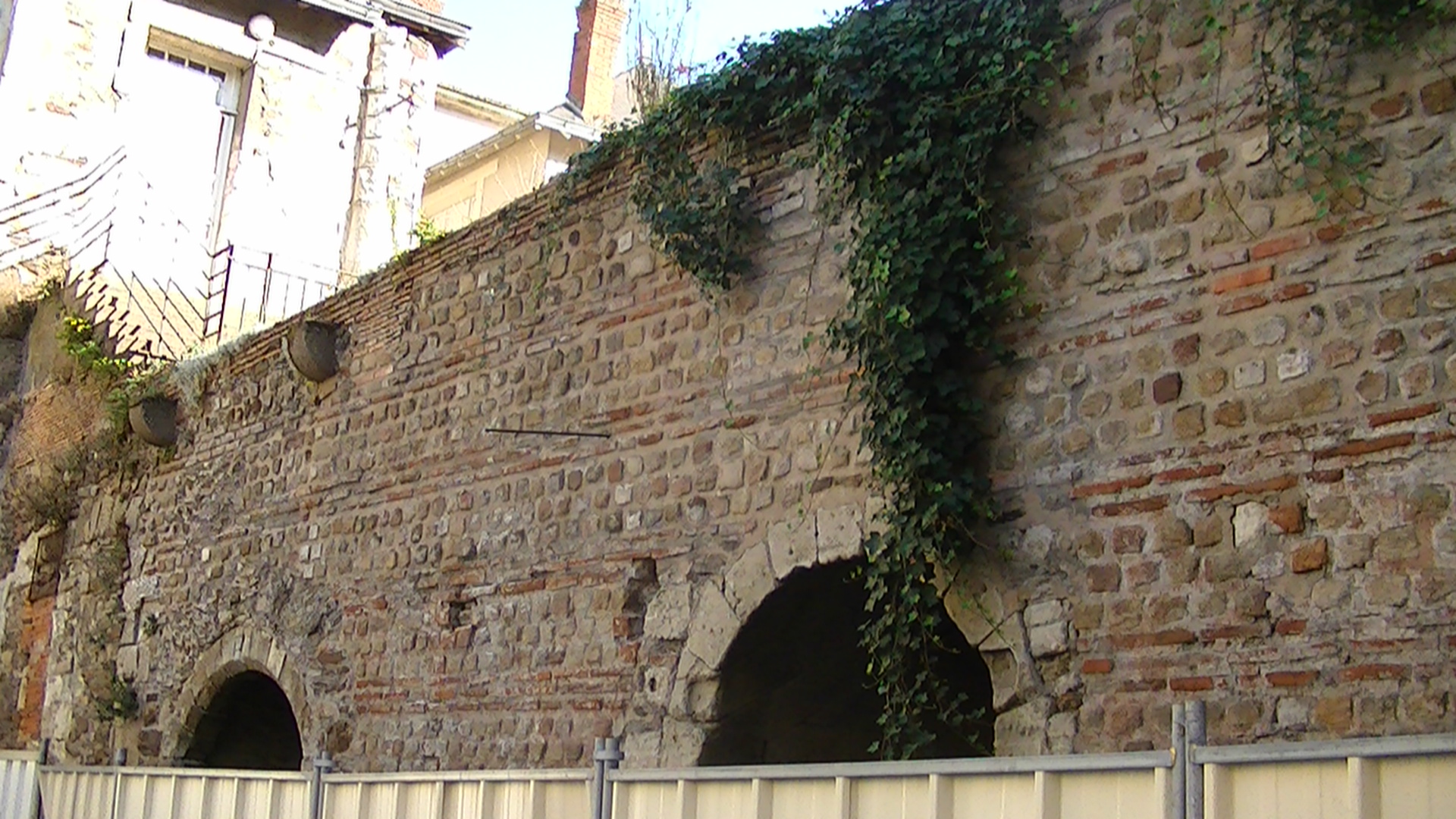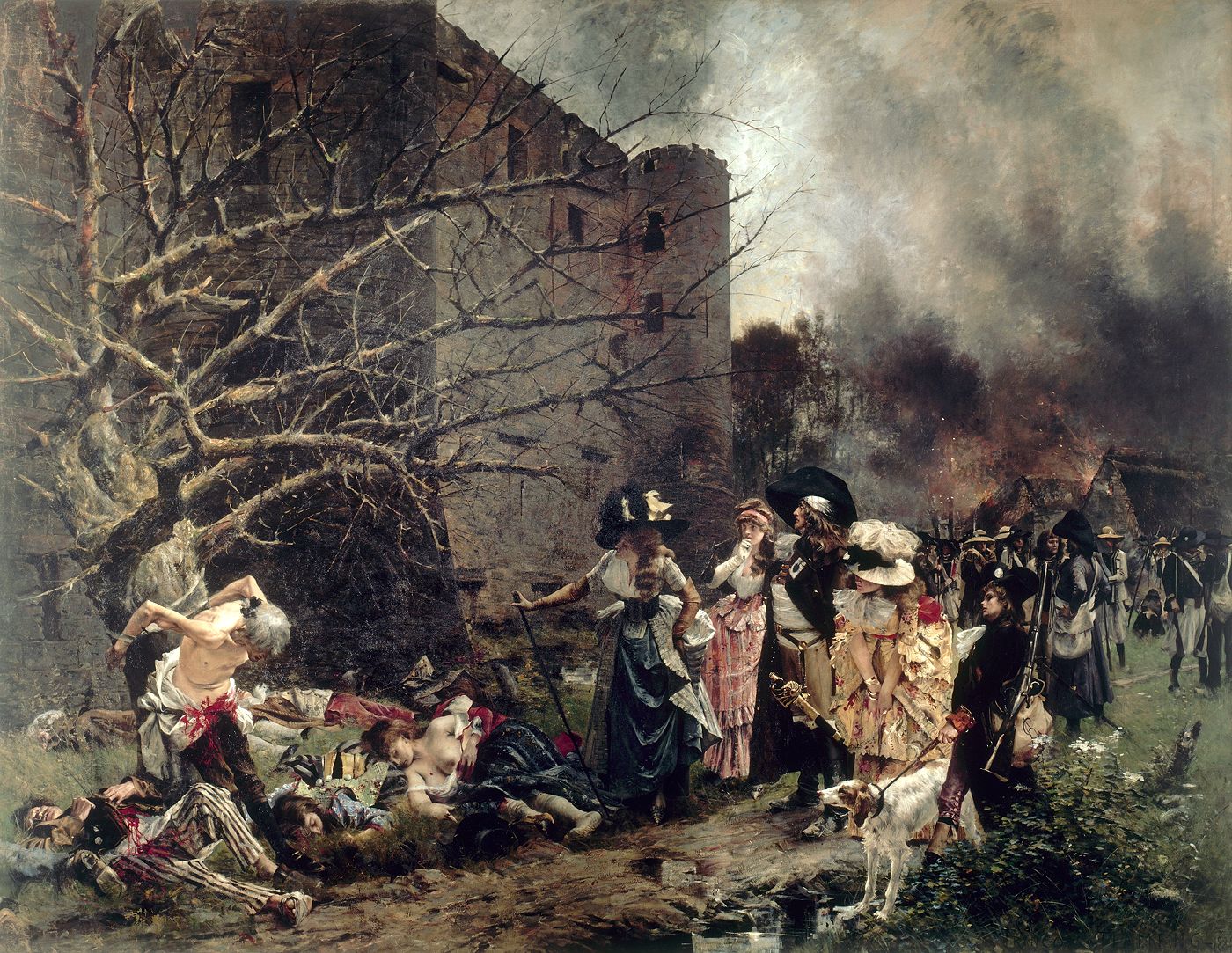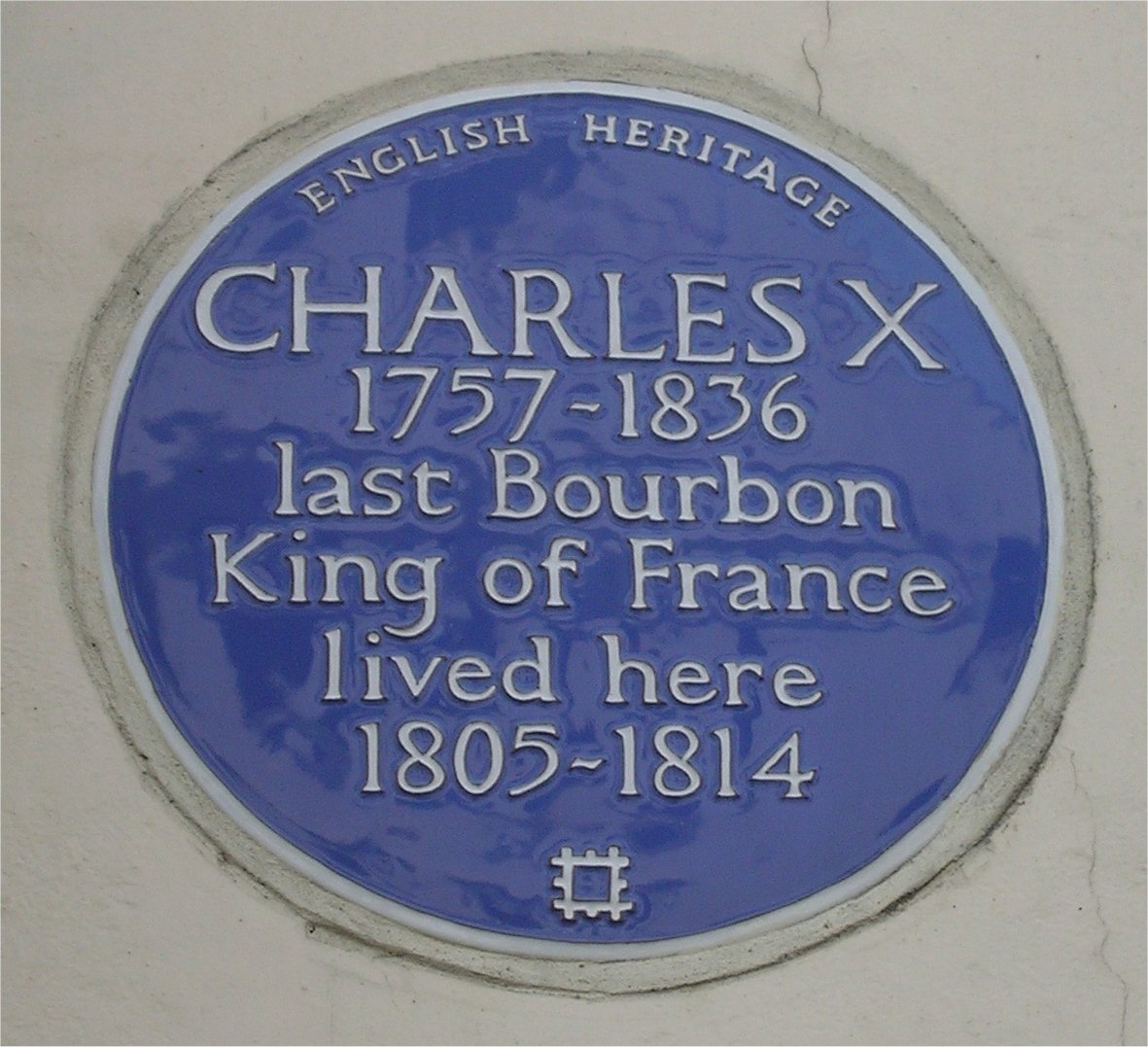|
Athanase-Charles-Marie Charette De La Contrie
Athanase Charles Marie de Charette, 2nd Baron de La Contrie (; 18 September 1832 in Nantes - 9 October 1911 in Saint-Père-Marc-en-Poulet), was a 19th-century French général who distinguished himself in the defense of the Papal States and subsequently during the Franco-German war of 1870. He was a grandson of Charles Ferdinand, Duke of Berry, the third child and younger son of Charles X, and Amy Brown, the Duke’s English mistress. Early life Athanase Charles Marie Charette de La Contrie was born on 3 September 1832, in Nantes, France. His great-grandfather was Charles X, the penultimate king of France, and his great-uncle, General de Charette, was shot in Nantes on 29 March 1795, during the War in the Vendée. His mother, Louise, Countess de Vierzon, was the daughter of the Duke of Berry and Amy Brown. As the Duchesse de Berry was at that time in hiding at Nantes, and Charette's father was being sought by the police, the child's birth was concealed; he was secretly tak ... [...More Info...] [...Related Items...] OR: [Wikipedia] [Google] [Baidu] |
Nantes
Nantes (, ; ; or ; ) is a city in the Loire-Atlantique department of France on the Loire, from the Atlantic Ocean, Atlantic coast. The city is the List of communes in France with over 20,000 inhabitants, sixth largest in France, with a population of 320,732 in Nantes proper and a metropolitan area of nearly 1 million inhabitants (2020). With Saint-Nazaire, a seaport on the Loire estuary, Nantes forms one of the main north-western French metropolitan agglomerations. It is the administrative seat of the Loire-Atlantique Departments of France, department and the Pays de la Loire Regions of France, region, one of 18 regions of France. Nantes belongs historically and culturally to Brittany, a former Duchy of Brittany, duchy and Province of Brittany, province, and Reunification of Brittany, its omission from the modern administrative region of Brittany is controversial. Nantes was identified during classical antiquity as a port on the Loire. It was the seat of a bishopric at the ... [...More Info...] [...Related Items...] OR: [Wikipedia] [Google] [Baidu] |
Général
is the French word for general. There are two main categories of generals: the general officers (), which are the highest-ranking commanding officers in the armed forces, and the specialist officers with flag rank (), which are high-level officers in the other uniformed services. General officers Army History The French army of the monarchy had several ranks of general officer: * ("brigadier of the armies of the King"): a rank in a grey area of seniority, conferred on certain colonels who were in command of a brigade (''cf.'' the grey area of the naval "commodore" rank given to certain captains, the equivalent of army full colonels, who had been in command of a group of ships and over the captains of the group's other ships). These officers wore a colonel's uniform with a star on the shoulder straps. This rank was abolished in 1788. * ("field marshal"(major general)): the first substantive rank of general. The wore a special uniform, blue and red, with a single bar of gold ... [...More Info...] [...Related Items...] OR: [Wikipedia] [Google] [Baidu] |
Turin
Turin ( , ; ; , then ) is a city and an important business and cultural centre in northern Italy. It is the capital city of Piedmont and of the Metropolitan City of Turin, and was the first Italian capital from 1861 to 1865. The city is mainly on the western bank of the Po (river), River Po, below its Susa Valley, and is surrounded by the western Alpine arch and Superga hill. The population of the city proper is 856,745 as of 2025, while the population of the urban area is estimated by Eurostat to be 1.7 million inhabitants. The Turin metropolitan area is estimated by the OECD to have a population of 2.2 million. The city was historically a major European political centre. From 1563, it was the capital of the Duchy of Savoy, then of the Kingdom of Sardinia (1720–1861), Kingdom of Sardinia ruled by the House of Savoy, and the first capital of the Kingdom of Italy from 1861 to 1865. Turin is sometimes called "the cradle of Italian liberty" for having been the politi ... [...More Info...] [...Related Items...] OR: [Wikipedia] [Google] [Baidu] |
Louis Philippe
Louis Philippe I (6 October 1773 – 26 August 1850), nicknamed the Citizen King, was King of the French from 1830 to 1848, the penultimate monarch of France, and the last French monarch to bear the title "King". He abdicated from his throne during the French Revolution of 1848, which led to the foundation of the French Second Republic. Louis Philippe was the eldest son of Louis Philippe II, Duke of Orléans (later known as Philippe Égalité). As Duke of Chartres, the younger Louis Philippe distinguished himself commanding troops during the French Revolutionary Wars and was promoted to lieutenant general by the age of 19 but broke with the First French Republic over its decision to execute King Louis XVI. He fled to Switzerland in 1793 after being connected with a plot to restore France's monarchy. His father fell under suspicion and was executed during the Reign of Terror. Louis Philippe remained in exile for 21 years until the Bourbon Restoration. He was proclaimed king ... [...More Info...] [...Related Items...] OR: [Wikipedia] [Google] [Baidu] |
Legitimist
The Legitimists () are royalists who adhere to the rights of dynastic succession to the French crown of the descendants of the eldest branch of the Bourbon dynasty, which was overthrown in the 1830 July Revolution. They reject the claim of the July Monarchy of 1830–1848 which placed Louis Philippe, Duke of Orléans, head of the Orléans cadet branch of the Bourbon dynasty, on the throne until he too was dethroned and driven with his family into exile. Following the movement of Ultra-royalists during the Bourbon Restoration of 1814, Legitimists came to form one of France's three main right-wing factions, which were principally characterized by their counter-revolutionary views. According to historian René Rémond, the other two right-wing factions were the Orléanists and the Bonapartists. Legitimists believe that the traditional rules of succession, based on the Salic law, determine the rightful King of France. The last ruling king whom Legitimists acknowledge as l ... [...More Info...] [...Related Items...] OR: [Wikipedia] [Google] [Baidu] |
Sainte-Reine-de-Bretagne
* Parc naturel régional de Brière
Sainte-Reine-de-Bretagne (, literally '' Saint Regina of Brittany''; ) is a commune in the Loire-Atlantique department in western France. Population See also *Communes of the Loire-Atlantique department The following is a list of the 207 communes of the Loire-Atlantique department of France. The communes cooperate in the following intercommunalities (as of 2025): References Communes of Loire-Atlantique {{LoireAtlantique-geo-stub ...[...More Info...] [...Related Items...] OR: [Wikipedia] [Google] [Baidu] |
Vierzon
Vierzon () is a Communes of France, commune in the Cher (department), Cher departments of France, department, Centre-Val de Loire, France. Geography A medium-sized town by the banks of the river Cher (river), Cher with some light industry and an area of forestry and farming to the north. It is situated some northwest of Bourges, at the junction of the D2020, D2076 and the D918 roads. Motorways encircle the town on three sides: the A85 autoroute, A85 and A71 autoroute, A71 on the north and east and the A20 autoroute, A20 on the north and west. Railways reached Vierzon in 1847 and the central SNCF hub Vierzon-Ville station, serving local and nation rail traffic, has been developed here ever since. History Little evidence remains of any pre-Ancient Rome, Roman occupation, and the Romans themselves didn't leave much trace of their occupation. Not until 926, when a Benedictine monastery was built (on the site of the current Town Hall) are there any records. The monks came from the ... [...More Info...] [...Related Items...] OR: [Wikipedia] [Google] [Baidu] |
War In The Vendée
The War in the Vendée () was a counter-revolutionary insurrection that took place in the Vendée region of French First Republic, France from 1793 to 1796, during the French Revolution. The Vendée is a coastal region, located immediately south of the river Loire in western France. Initially, the revolt was similar to the 14th-century Jacquerie peasant uprising, but the Vendée quickly became counter-revolutionary and House of Bourbon, Royalist. The revolt was comparable to the Chouannerie, which took place concurrently in the area north of the Loire. While elsewhere in France the revolts against the were repressed, an insurgent territory, called the by historians, formed south of the Loire-Atlantique, Loire-Inférieure (Brittany), south-west of Maine-et-Loire (Duchy of Anjou, Anjou), north of Vendée and north-west of Deux-Sèvres (Poitou). Gradually referred to as the "Vendeans", the insurgents established in April a "Catholic and Royal Armies, Catholic and Royal Army" wh ... [...More Info...] [...Related Items...] OR: [Wikipedia] [Google] [Baidu] |
François De Charette
François Athanase de Charette de la Contrie (; 2 May 1763 – 29 March 1796) was a French military officer and politician. He served in the French Navy during the American Revolutionary War and was one of the leaders of the War in the Vendée against the French Revolutionary Army. His great-nephew Athanase-Charles-Marie Charette de la Contrie was a noted military leader and great-grandson of Charles X of France. Life Early activities A French nobility, nobleman born in Couffé, arrondissement of Ancenis, Charette served in the French Navy under Toussaint-Guillaume Picquet de la Motte, notably during the American War of Independence, and became ''lieutenant de vaisseau''. He notably served on the 74-gun French ship Hercule (1778), ''Hercule'', under Alexandre Honoré Louis de Puget-Bras, Puget-Bras. Following the outbreak of the French Revolution, he quit the Navy in 1789 and Émigré, emigrated to Koblenz (Trier) in 1792 (a common move for Monarchism in France, royalist aristoc ... [...More Info...] [...Related Items...] OR: [Wikipedia] [Google] [Baidu] |
Amy Brown (royal Mistress)
Amy Brown (8 April 1783 – 7 May 1876) was the English mistress of Charles Ferdinand, Duke of Berry, younger son of King Charles X of France and Marie Thérèse of Savoy. Some authors have stated that they married in a secret ceremony which was conducted in England by her father, a Protestant pastor, but there is no evidence of it. Together they had two daughters; however, when he returned to France, he was constrained to put an end to his relationship for reasons of state. Early years Amy Brown was born on 8 April 1783 in Maidstone, Kent, England, as the fifth child of eight born to John L. (in other sources named Joseph) Brown, a Protestant pastor, and his wife Mary Ann Deacon. By 1793, Amy's four older siblings had died in infancy or early youth, and thus she became the eldest surviving child of her parents. On 10 January 1804 Amy gave birth a daughter, named Georgina Emma Marshall. Her second child, a son named Georges Granville Brown, was born on 20 February 1805 and ten m ... [...More Info...] [...Related Items...] OR: [Wikipedia] [Google] [Baidu] |
Charles X Of France
Charles X (Charles Philippe; 9 October 1757 – 6 November 1836) was King of France from 16 September 1824 until 2 August 1830. An uncle of the uncrowned Louis XVII and younger brother of reigning kings Louis XVI and Louis XVIII, he supported the latter in exile. After the Bourbon Restoration in France, Bourbon Restoration in 1814, Charles (as heir-presumptive) became the leader of the ultra-royalists, a radical monarchist faction within the French court that affirmed absolute monarchy by Divine Right of Kings, divine right and opposed the constitutional monarchy concessions towards Classical liberalism, liberals and the guarantees of civil liberties granted by the Charter of 1814. Charles gained influence within the French court after the assassination of his son Charles Ferdinand, Duke of Berry, in 1820 and succeeded his brother Louis XVIII in 1824. Charles's reign of almost six years proved to be deeply unpopular amongst the liberals in France from the moment of Coronation of ... [...More Info...] [...Related Items...] OR: [Wikipedia] [Google] [Baidu] |









